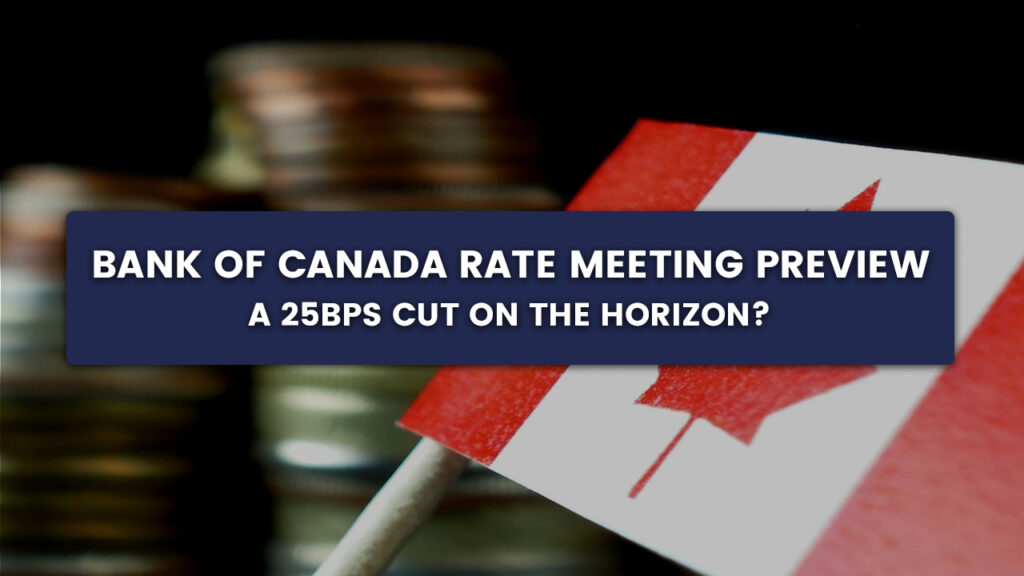Bank of Canada Rate Meeting Preview: A 25bps Cut on the Horizon?
Article published on January 28th, 2025 9:57AM UK Time

The Bank of Canada (BoC) is set to announce its latest policy decision on Wednesday, with markets widely anticipating a 25bps cut to bring the policy rate down to 3.00%. While there are arguments for the central bank to pause the easing cycle, several economic headwinds and external risks suggest the BoC could lean towards further accommodation, with heightened tariff uncertainties likely to weigh on the economy in early 2025.
The Case for a Cut
Recent data suggest that economic growth in Canada remains subdued, with ongoing external challenges from weaker global demand and uncertainty surrounding trade policies. The BoC has previously signalled concerns about downside risks to economic activity, and these have likely been exacerbated by recent geopolitical developments.
Markets have priced in the possibility that 3.00% could represent the extent of the cut, aligning with forecasts from Scotiabank. However, the lack of significant progress in inflation cooling and persistent softness in housing and consumer spending could nudge policymakers towards acting now to preemptively address these risks – watch for a deeper cut or revisions lower in forecasts for more CAD weakness.
Potential for a Pause
On the other hand, despite expectations for a cut and STIR markets price it in at 100%, the BoC has reasons to pause. Labour markets remain relatively tight, and inflation, while easing, is still towards the higher end of the 1-3% target (Trim and median readings). A pause would allow policymakers to gauge the impact of recent rate cuts, as monetary policy effects tend to lag. With global monetary conditions still evolving—especially as the Federal Reserve takes a more cautious approach—the BoC might prefer to avoid over-committing to easing too quickly.
Market Implications: The CAD Reaction
The Canadian dollar’s reaction will largely hinge on the tone of the BoC’s guidance. If the bank delivers the expected 25bps cut but signals that rates may remain steady thereafter, the CAD could stabilise or even gain modestly, reflecting relief that the easing cycle may not deepen further. Conversely, a dovish tone, hinting at further cuts, would likely weaken the CAD, particularly as US policy holds steady.
The Context of the FOMC Decision
The BoC’s decision coincides with a highly anticipated Federal Reserve announcement later that day. The FOMC is widely expected to hold rates steady, with recent statements suggesting that while further rate cuts remain on the table, they will approach easing with caution. The Fed’s messaging may have to strike a hawkish tone, given the limited progress on inflation since mid-2024. A hawkish Fed stance could lend support to the USD, creating a potentially challenging dynamic for the CAD.Despite cooling inflation trends, risks remain skewed to the upside. The Fed doesn’t expect core inflation to return to its 2% target until 2027 with a reading of 2.5% for 2025 and 2.2% for 2026, and analysts warn that the administration’s trade policies could reintroduce inflationary pressures. Barclays notes that if the U.S. imposes significant new tariffs, “disinflationary pressures could stall,” potentially delaying Fed rate cuts or forcing the central bank to hold rates for longer.
Conclusion: A Pivotal Moment for the BoC
While the market is fully priced for a 25bps cut, the real driver for CAD and broader market sentiment will be the BoC’s forward guidance. If the BoC take pre-emptove action to the prospect of tariffs on exports to Canada don’t rule out a deeper 50bps cut.
If we see a 50bps cut then watch for immediate CAD weakness and USDCAD buying at market and CAD selling in the futures market. With key global central banks, including the Fed, now leaning towards caution, the BoC’s messaging will be critical in shaping expectations for the Canadian economy and its currency heading into 2025.